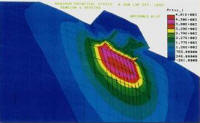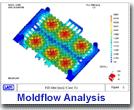  |
ATI utilizes Finite Element Analysis (FEA), a computer tool that is useful in evaluating design concepts by helping to predict design would respond to anticipated manufacturing and end-use situations. Computer based simulation tools are used to analyze the following performance behaviors:
- Structural: stress on and deflection of components and assemblies under various load situations
- Fluid Flow: gas and fluid flow based on geometry and fluid properties
- Magnetism: magnetic field strength and geometry
- Thermal: component and assembly temperature profiles based on material properties, heat sources, heat sinks
- Electrical: potential across components
The results of FEA can:
- Assist in determining initial feasibility of a concept before engaging in more costly design.
- Permit the design to be more easily and accurately refined before the tooling process is started; resulting in reduced cost and lead time getting a fully functional product to market.
By combining FEA techniques with decades of design experience, ATI provides reduced lead times and cost in the creation of functional, reliable, and cost effective end products for our clients.
Similarly, Mold Fill Analysis is a method of simulating the behavior of a polymer during the injection molding process. Mold fill analysis provides valuable information relative to the predicted quality of the molded part.
- Mold fill rate and sequence of fill: keys to dimensionally uniform and stress free molded parts
- Part cooling rate: assists in achieving sink free and uniform parts
- Location of weld lines: important for control of part strength, dimensional uniformity, and appearance
- Location of gas traps: essential for the prevention of voids and blemished regions of the part
Mold Fill Analysis, by predicting part fill behavior, provides the engineer with the ability to refine part geometry and optimize gate and runner configuration to:
- Maximize molded part performance and appearance prior to making the mold
- Optimize gating and cooling in the mold for quality parts at reduced cycle time prior to making the mold
- Establish preliminary molding process conditions to facilitate start-up
The final outcome is to:
- Reduce part development time and associated mold build cost
- Increase molding machine output and product quality